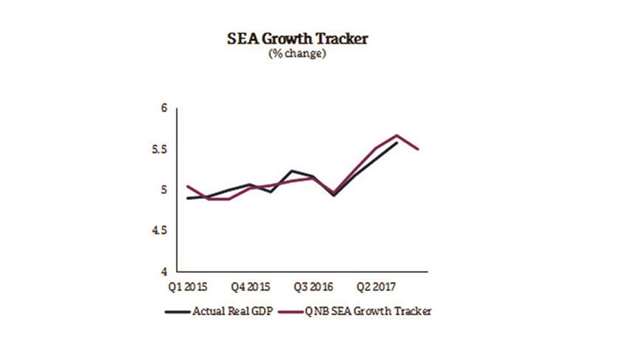The report said growth has increased each year and averaged a robust 4.9% since 2014. The SEA countries now collectively account for over 5% of global GDP, ranking third among emerging market economies behind China and India.
Much of this growth has been led by domestic fiscal policies aimed at closing the region’s infrastructure gap, supportive monetary policy, favourable demographics, and firming global trade, according to QNB.
“However, we have developed a growth tracker that suggests that SEA growth may have dipped in Q4 2017 as a result of a cooling in public and private investment,” the QNB report said.
“To track SEA’s increasing prominence in the global economy we have developed a model to monitor the region’s economic growth in the latest quarter. Our focus is on the largest five economies in the region: Indonesia, Philippines, Thailand, Malaysia, and Vietnam.
“More specifically, we model each country’s GDP growth using higher frequency monthly data and combine the models to construct an aggregate indicator for SEA growth. Broadly speaking, the models use higher frequency monthly data to predict quarterly real GDP growth in the latest or current quarter before the actual data is released,” it added.
QNB said the models incorporate five main elements.
“First, we utilise industrial or manufacturing production indices as a proxy for investment. Industrial production is closely linked to GDP growth across all five countries and provides comprehensive sectoral coverage of the economy, including manufacturing, agriculture, construction and energy – the largest and most important sectors in SEA.
“Second is retail sales. Monthly retail sales data exist for each country in our sample except for the Philippines. This measure essentially captures consumption, which accounts for over half of the aggregated GDP amongst the SEA economies in question,” QNB said.
The third main element is the changes in the exchange rates relative to the dollar. Across all four jurisdictions, exchange rate movements are reliable predictors of changes in net exports. As currencies weaken, it depresses imports and boosts the competitiveness of exports.
“Fourth, we include monthly changes in the fiscal balance to reflect current and capital spending by the government. Considering the strong push by governments in the region to boost public investment spending, this is an important measure to capture that impact on growth in addition to the spillover effect felt through industrial production,” QNB said.
The fifth element is growth recorded in the previous quarter. Often positive or negative sentiment from the previous quarter can impact consumer and investment intentions in the current period. The standard method to capture this type of dynamic is to include previous or lagged values of growth of one quarter.
“Putting the individual results together shows that our model tracks actual GDP relatively well historically,” QNB said.
The report said the model predicts that SEA GDP growth in Q4 2017 should slow very slightly from 5.6% in Q3 to 5.5%. The slight dip in growth appears to be driven by softening industrial production data in Thailand, Malaysia, and the Philippines.
QNB said this is largely reflective of a cooling of private and public investment, which had gained substantially at the start of the year on firming external demand and increased government spending.
“Nevertheless, growth in SEA appears strong and on pace to average 5.0% in 2017, a slight uptick from growth of 4.9% in 2016 and the fourth consecutive year of higher growth,” QNB said.

